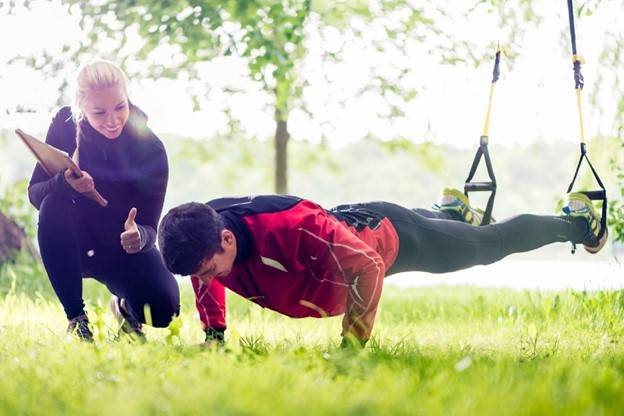Get back in shape for good this time with these five tips for pain-free exercise. We’re here to help, from your warm-up to your cool-down.

March 2022. This article is independently written by Shelby Golding. All opinions given are hers. Shelby has been certified as a personal trainer and nutritional specialist since 2007. In 2008, she found her passion for writing about these topics and hasn't looked back.

Both types of pain might be an inconvenience, but they are clear signs that you are getting stronger and building endurance. As the saying goes, “no pain, no gain.”
But sometimes, the pain you feel during exercise is an indication that something is wrong. These pains are usually severe, sharp, and persistent. Pain during exercise should never affect how you move, and you should not have to "push through the pain" to get to the end of your workout. Persistent, sharp pain indicates an injury.
You are more likely to meet your fitness goals if you find a way to exercise without pain. These five tips for pain-free exercise will help you prevent injury in your daily workout routine.
5 Tips for Pain-Free Exercise
As you start incorporating these pain-free exercise tips, listen to your body's signals. Pain is a prompt from your body to pay attention. So tune in to what your muscles are saying throughout your workout for the best results.
1. Warm Up
The idea that you need to warm up before a workout is not a myth. Picture your body as a rubber band. A rubber band retains elasticity and can easily be stretched when in regular use. However, say that rubber band falls behind the stove, and you do not find it until a few years later. What happens when you stretch it? It breaks.
Your muscles need regular stretching to remain flexible. For example, you may have noticed that you are stiffer in the morning than in the afternoon. When you are inactive for several hours in a row (like when you are sleeping), the synovial fluid in your joints stiffens. But even if you work out in the evening, you will want to incorporate some warm-up exercises.
A warm-up routine for pain-free exercise does not mean stretching. Stretching cold, stiff muscles could cause muscle pulls or tears. Instead, you should add targeted movements that warm up the specific muscles you are working out that day. For example, you should do a few air squats or lunge twists on leg day to warm up the leg muscles and spine.
Your muscles need regular stretching to remain flexible. For example, you may have noticed that you are stiffer in the morning than in the afternoon. When you are inactive for several hours in a row (like when you are sleeping), the synovial fluid in your joints stiffens. But even if you work out in the evening, you will want to incorporate some warm-up exercises.
A warm-up routine for pain-free exercise does not mean stretching. Stretching cold, stiff muscles could cause muscle pulls or tears. Instead, you should add targeted movements that warm up the specific muscles you are working out that day. For example, you should do a few air squats or lunge twists on leg day to warm up the leg muscles and spine.
2. Cool Down
After your workout, muscles tighten back up, and your risk of injury increases. Even a few minutes of stretching will help reduce stiff, sore muscles that are the natural result of exercising.
Lactic acid is the primary culprit for sore, achy muscles after a workout. Stretching after your training reduces lactic acid build-up. As you slow down and begin to take deeper breaths, the release of lactic acid into the bloodstream stops, and the body starts to replace the oxygen deficit.
Stretching also increases flexibility. When you exercise, your muscles constrict and contract. Tight and stiff muscles almost always result in an injury down the line. Flexibility prevents injury while increasing muscle power and stability.
You may also notice that you feel happier and more energized during your cool-down. This is because the body releases endorphins from the workout about 30 minutes after moderate to intense exercise.
3. Use Your Diet
Your diet is an essential tool in the fight against pain. A healthy anti-inflammatory diet is especially effective for fighting joint pain resulting from system inflammation. Chronic pain conditions like arthritis and fibromyalgia wreak havoc on the joints, causing pain no matter the intensity of your exercise.
Even if you do not have a chronic pain condition, you need a healthy diet if you exercise frequently. This is because your body uses food for fuel. Your diet determines the speed of your metabolism, whether you gain or lose weight, the health of your digestion, how much muscle you build, and the speed of your recovery.
To make progress with your exercise routine, you also need to pay attention to what you eat.
An unhealthy diet filled with processed foods, red meat, sugar, and unhealthy fats will increase pain and discomfort. Temporary indulgences in your favorite snack foods are not the problem. The constant assault of fats, sugars, and chemicals results in systemic inflammation.
4. Practice Good Form
If you are new to working out, you will need to practice good form. Whether running, swimming, lifting weights, riding a bike, hiking, or dancing – good form is essential to prevent injury.
Picture the parts of our body as the cogs in a machine. When they all move in sync, the machine runs smoothly. But if one of the wheels or cogs falls out of alignment, the whole system stops working.
While your body is infinitely more complicated than any artificial machine, the analogy holds. When one part of our body is injured or in pain, we naturally compensate by taking on more weight and pressure in other parts of the body. After a while, pain develops in different places because of the increased strain.
When we practice good form, we make sure that the moving pieces are working together in harmony. For example, the hips need to be lined up over the feet, our core must stay engaged, our joints are at a 90-degree angle when lifting. Poor form puts strain on specific muscles, tendons, and ligaments, which can lead to sprains and strains.
You can learn a lot about good form online. But if you are new to that type of exercise, your best course of action might be to ask a professional trainer for advice.
Picture the parts of our body as the cogs in a machine. When they all move in sync, the machine runs smoothly. But if one of the wheels or cogs falls out of alignment, the whole system stops working.
While your body is infinitely more complicated than any artificial machine, the analogy holds. When one part of our body is injured or in pain, we naturally compensate by taking on more weight and pressure in other parts of the body. After a while, pain develops in different places because of the increased strain.
When we practice good form, we make sure that the moving pieces are working together in harmony. For example, the hips need to be lined up over the feet, our core must stay engaged, our joints are at a 90-degree angle when lifting. Poor form puts strain on specific muscles, tendons, and ligaments, which can lead to sprains and strains.
You can learn a lot about good form online. But if you are new to that type of exercise, your best course of action might be to ask a professional trainer for advice.
5. Work With a Trainer

That leads to the final tip for pain-free exercise: working with a trainer. Professional trainers work with you to create a workout plan for your body based on your own unique needs and limitations. Trainers also challenge you when you are becoming too comfortable. They will let you know when they think you are ready to take the next step toward your workout goals.
If you are working through an injury, you might need someone to help you come up with modifications. A trainer not only provides options but works with you to hold you accountable for your goal. In addition, they make working out accessible and safe.
Exercise Lifestyle
The goal behind these tips for pain-free exercise is to allow you to turn working out into a habit. Exercise helps you maintain a healthy weight, prevent disease, sleep better, and improve the overall quality of your life. But exercising once a month or only on days when you are in the mood will not achieve the same results as regular, consistent exercise.
Use these tips to remove any reservations about exercising worsening your pain – it’s time to turn your workout routine into a part of your lifestyle for good.
And don’t forget to use your Kailo pain patch to manage chronic issues. A recent clinical study showed that 99% of patients felt pain relief with Kailo within 10 minutes of application. What are you waiting for?
Use these tips to remove any reservations about exercising worsening your pain – it’s time to turn your workout routine into a part of your lifestyle for good.
And don’t forget to use your Kailo pain patch to manage chronic issues. A recent clinical study showed that 99% of patients felt pain relief with Kailo within 10 minutes of application. What are you waiting for?
Disclaimer: Kailo should not be used if you have a pacemaker or if you are pregnant. Always consult your doctor or health care professional before using Kailo.
